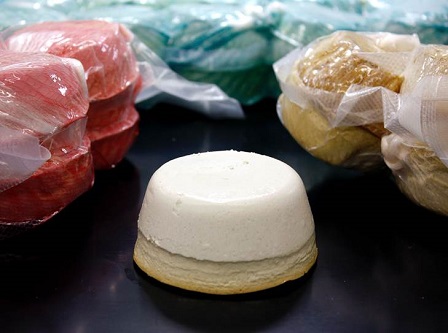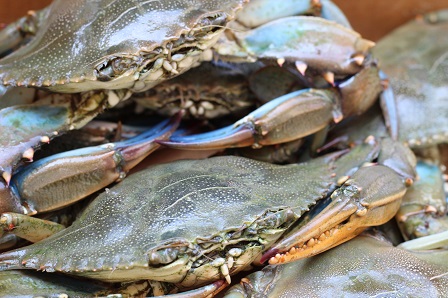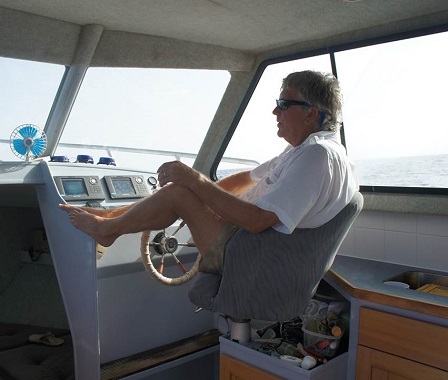By REBECCA NAGY
Rebecca Nagy graduated from North Carolina State University with a degree in English and a minor in environmental science.
Kepley Biosystems, Inc. is catching a lot of funding with their alternative crab bait.
Since receiving support from North Carolina Sea Grant for a pilot study to test Organobait™, KBI has leveraged $168,750 in grants from the National Science Foundation and matching grants from the N.C. Department of Commerce’s One North Carolina Fund.
In addition, Anthony Dellinger, KBI’s president, received the University of North Carolina Greensboro’s Jerry McGuire Student Entrepreneur Award for his work with Organobait while he was working on his doctoral degree.

Kepley Biosystems, Inc. hopes to alleviate the pressure on forage fish with this bait alternative, Organobait. Photo by Lee Robertson.
Globally, “Organobait is addressing a $20 billion annual market opportunity,” says Chris Kepley, the organization’s founder who also is a nanoscientist at the UNCG Joint School of Nanoscience and Nanoengineering, or JSNN.
The company’s patent-pending, nontoxic and biodegradable bait is designed to release chemicals that attract crustaceans without the need for any fish- or mammal-derived material. Its active ingredients are manufactured synthetically and do not come straight from natural sources.
“What steered us toward this problem was the state of the ocean in general and the impending collapse of forage fish being more and more recognized in the media,” notes Dellinger, who also is a faculty member at JSNN.
“Once we started to dig into the literature more, we found that these little fish were suffering a great deal and there weren’t that many people doing things to help alleviate it,” he adds.
And it’s not an easy process for crabbers either. Before catching a crab, they must catch fish for bait. It costs time and money.
Once caught, baitfish must be stored and kept cold to preserve until fishermen are ready to use them.
Menhaden is a popular baitfish in North Carolina’s blue crab pot fishery. Blue crab fishermen used an estimated 11.2 million pounds of menhaden as bait, spending $3 million on the species for that purpose, according to the N.C. Division of Marine Fisheries.
While menhaden may not be a fish that you picture on your dinner plate, it is an important prey item to many commercially caught fish as well as birds and other wildlife.
“But with recent harvest restrictions on the species, along with on other baitfish species, the ‘bait of choice’ is becoming more varied,” notes Sea Grant fisheries specialist Sara Mirabilio. “Since striped mullet are a viable fishery, I know some fishermen are using that species increasingly as bait.”
Striped mullet play a role in the food chain as well. The more menhaden and other fish are caught for bait, the less remain in the ocean for predator species to consume.
“To date, a widely used artificial bait for blue crab commercial fisheries does not exist,” Mirabilio says. Her idea of a successful bait would be one that would reuse available waste products, such as shrimp heads; be cost effective; be available year-round; and decrease fishing pressure on bait species.
• Attracting Crabs
Organobait’s creators see their product alleviating the pressure.
As part of the Sea Grant-funded pilot study, KBI formulated different concentrations of the chemical attractants to compare with standard crab and lobster bait in lab and field trials.
Pots with each type of bait were placed in fishing grounds for one to two days, depending on water temperature and fishermen’s suggestions.
The alternative bait did attract crabs.

Fishermen typically use a range of bait, from menhaden to chicken scraps, to catch blue crabs. Photo by Vanda Lewis.
Initial testing — eight trips comparing Organobait and standard bait in the field — showed catch values were comparable in field tests from Kitty Hawk, N.C., to Richmond, Maine.
In the days when raw fish bait outperformed Organobait, the participants reported that the new bait dissolved too fast.
Using the leveraged funding for further testing, the KBI team is continuing efforts to create a product that will last longer in the water than traditional bait.
“Organobait is undergoing field-testing in real-world baiting circumstances with commercial fishing industries throughout the United States and learning about each market’s needs,” Kepley notes, adding that there are additional challenges for his product.
“As it turns out, different species of animals require unique baiting characteristics,” he explains. The company is working to tweak Organobait to be effective in different catch circumstances worldwide.
Kepley and his colleagues also are spreading the word about the product and seeking additional funding.
Although the company did not make a television appearance, Organobait was a finalist for Shark Tank, a reality program that provides a platform for entrepreneurs and inventors to seek funding from investors.

Terry Brady is chief fishing officer for KBI. Photo courtesy Terry Brady.
Locally, Kepley and the team pitched their product at the BioMarine International Business Conference in Wilmington, in October 2015. Executives from industries related to marine resources, including aquaculture, pharmaceuticals and clean technology, attended the event.
KBI also is recruiting students interested in learning about technology and all aspects of the business. Currently, graduate and undergraduate interns have a variety of projects, including web design and labwork.
Terry Brady, the KBI chief fishing officer and Dellinger’s mentor, has high hopes for this product.
“It could reduce cost by 33 to 50 percent,” says Brady, a retired entrepreneur and commercial lobsterman. He notes that using the alternative bait has the potential to eliminate the costs and variability involved with capture and purchase of traditional bait, including fluctuating fuel costs, unpredictable catch and market availability.
The use of such a product could mitigate the removal of forage fish and bycatch that go along with bait fish capture, he notes.
“Organobait is stable, can be stored at room temperature, and has an extensive shelf life that is attractive to dealers and fishers alike,” he adds.
Read the three other stories in this series
- Minigrants: Fast, Simple, Noteworthy
John Fear highlights the strengths of the minigrant program. - Jellyfish in Bloom: Are Humans Contributing to Local Populations?
Scientists test Atlantic sea nettles’ preference for man-made and natural surfaces. - Algae Patrol: Documenting a Changing Community
A researcher examines the arrival of tropical species.
This article was published in the Holiday 2015 issue of Coastwatch. For an update on this research and company, check out this UNC-TV Science story from April 2018.
For contact information and reprint requests, visit ncseagrant.ncsu.edu/coastwatch/contact/.
